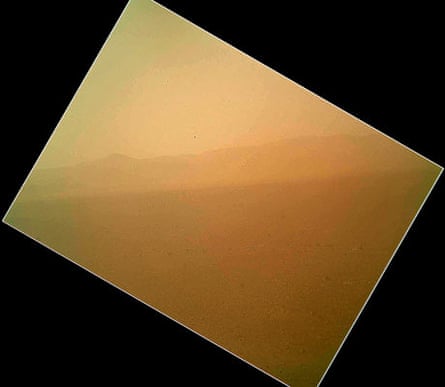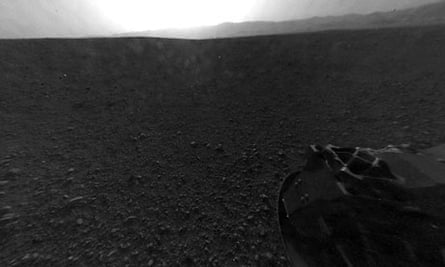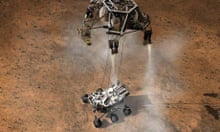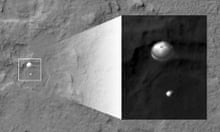Nasa's Curiosity rover has transmitted its first colour photo and a low-resolution video showing the last 2 1/2 minutes of its dramatic dive through the Martian atmosphere, giving an insight into a spacecraft landing on another world.
As thumbnails of the video flashed on a big screen on Monday, scientists and engineers at the Nasa Jet Propulsion Laboratory let out "oohs" and "aahs."
The recording began with the protective heat shield falling away and ended with dust being kicked up as the rover was lowered by cables inside an ancient crater. It will be some time before full-resolution frames are beamed back.
The full video "will just be exquisite," said Michael Malin, the chief scientist of the instrument.
The first colour photo from the crater where Curiosity landed showed a pebbly landscape and the rim of Gale Crater off in the distance. Curiosity snapped the photo on its first day on the surface after touching down Sunday night.
The rover took the shot with a camera at the end of its robotic arm. The landscape looked fuzzy because the camera's removable cover was coated with dust that kicked up during the descent.

Nasa celebrated the precision landing of a rover on Mars and marveled over the mission's flurry of photographs grainy, black-and-white images of Martian gravel, a mountain at sunset and, most exciting of all, the spacecraft's plunge through the red planet's atmosphere.
Curiosity is the heaviest piece of machinery Nasa has landed on Mars, and the success gave the space agency confidence that it can unload equipment that astronauts may need in a future manned trip to the red planet.
The roving laboratory, the size of a compact car, landed right on target after an eight-month, 352m-mile (566m-kilometer) journey. It parked its six wheels about four miles (6 kilometers) from its ultimate science destination Mount Sharp, rising from the floor of Gale Crater near the equator.
Extraordinary efforts were needed for the landing because the rover weighs one ton, and the thin Martian atmosphere offers little friction to slow down a spacecraft. Curiosity had to go from 13,000 mph (21,000 kph) to zero in seven minutes, unfurling a parachute, then firing rockets to brake. In a Hollywood-style finish, cables delicately lowered it to the ground at 2 mph (3 kph).
At the end of what Nasa called "seven minutes of terror", the vehicle settled into place almost perfectly flat in the crater it was aiming for.
"We have ended one phase of the mission much to our enjoyment," mission manager Mike Watkins said. "But another part has just begun."
The nuclear-powered Curiosity will dig into the Martian surface to analyze what's there and hunt for some of the molecular building blocks of life, including carbon.

It won't start moving for a couple of weeks, because all the systems on the $2.5bn rover have to be checked out. Colour photos and panoramas will start coming in the next few days.
But first Nasa had to use tiny cameras designed to spot hazards in front of Curiosity's wheels. So early images of gravel and shadows abounded. The pictures were fuzzy, but scientists were delighted.
The photos show "a new Mars we have never seen before," Watkins said. "So every one of those pictures is the most beautiful picture I have ever seen."
A high-resolution camera on the orbiting seven-year-old Mars Reconnaissance Orbiter, flying 211 miles (340 kilometers) directly above the plummeting Curiosity, snapped a photo of the rover dangling from its parachute about a minute from touchdown. The parachute's design can be made out in the photo.
"It's just mind-boggling to me," said Miguel San Martin, chief engineer for the landing team.




Comments (…)
Sign in or create your Guardian account to join the discussion